

Flood Map: Elevation Map, Sea Level Rise Map. Los huesos más antiguos de nuestra especie están en Marruecos. Reconstrucciones del cráneo de los primeros fósiles de Homo sapiens descubiertos en el yacimiento de Jebel Irhoud (Marruecos). / Philipp Gunz, MPI EVA Leipzig La idea de que los humanos modernos evolucionaron en el este de África hace 200.000 años ha dejado de ser válida.
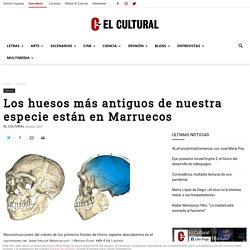
Un equipo de paleoantropólogos ha descubierto restos óseos de Homo sapiens de unos 300.000 años de antigüedad en el yacimiento Jebel Irhoud, en Marruecos, un hallazgo revolucionario que adelanta 100.000 años los orígenes del Homo sapiens. Los científicos acaban de mover los orígenes de nuestra especie en el espacio y en el tiempo. Hasta ahora se pensaba que los restos de Homo sapiens más antiguos eran los encontrados en el este de África hace unos 200.000 años, pero se acaban de identificar huesos de cráneo, cara y mandíbula de miembros tempranos de nuestra especie en un yacimiento de Marruecos y se han fechado en cerca de 315.000 años.
Cronología de un gran descubrimiento. Arbre homínids - homo & evolució. Washington State University.

Recerca en accio. Evolucio-humana-arbre-de-familia - eduCaixa – Recursos educatius per a l’aula. All you need is Biology. Amb més de cinc mil anys d’edat, Ötzi és la mòmia humana més antiga que es coneix i una de les més estudiades per la ciència.

Va ser descoberta en 1991 als Alps i des de llavors no ha deixat de donar informació sobre com era la vida al Neolític. T’animes a descobrir tots els seus secrets? Les mòmies són cossos conservats de persones i animals que encara conserven la pell. Human Anatomy and Disease in Interactive 3D. Geografia. El bloc de 2n de batxillerat. A meitats del segle XX es va produir el major creixement demogràfic de la història, al 1950 al món hi havien un 2.500 milions de persones, al 2015 s’ha arribat als 7.347.
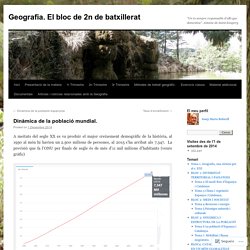
Population Clock: World. Site. Juegos de Ciencias Naturales. Gràfics a les Ciències Socials. Quan es vol representar l'estructura de la població per grups d'edats i sexes.
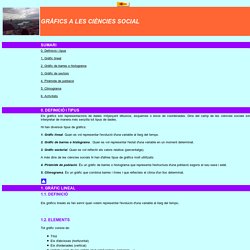
Videos - Stated Clearly. Stated Clearly is creating animations on genetics and evolution. ¿Qué es el ADN y Cómo Funciona? GLACIARES E INTERGLACIARES Y SUS EFECTOS SOBRE LOS ECOSISTEMAS. Desde que diera comienzo el Período Cuaternario, hace dos millones y medio de años, se han reconocido seis etapas glaciares y seis interglaciares.
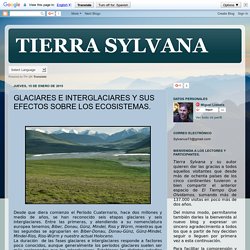
Entre las primeras, y atendiendo a su nomenclatura europea tenemos; Biber, Donau, Günz, Mindel, Riss y Würm, mientras que las segundas se agruparían en Biber-Donau, Donau-Günz, Günz-Mindel, Mindel-Riss, Riss-Würm y nuestro actual Holoceno. La duración de las fases glaciares e interglaciares responde a factores poco conocidos, aunque generalmente los períodos glaciares suelen ser más prolongados que los interglaciares. Establecer los distintos estadios es siempre bastante subjetivo, pues dentro de ellos podemos encontrar tal variación climática y de biotopos que algunos de los interestadiales de por ejemplo un interglaciar han sido mucho más fríos que otros que se dieron durante una glaciación, y viceversa. Como consecuencia de todo ello la evolución de los ecosistemas es siempre cambiante dependiendo de las distintas fases climáticas.
Blog d'Humanitats. Els fòssils més antics d’Homo sapiens (els anteriorment esmentats Omo I i II) tenen una antiguitat de gairebé 200.000 anys i procedeixen del sud d’Etiòpia (formació Kibish del riu Omo), considerada com el bressol de la humanitat .
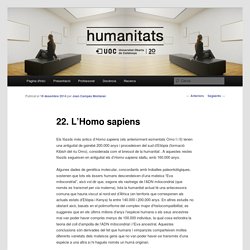
A aquestes restes fòssils segueixen en antiguitat els d’Homo sapiens idaltu, amb 160.000 anys. La historia del clima - Revista del Aficionado a la Meteorología. En mi indagación personal sobre el tema del Cambio Climático he intentado aprender algo sobre el pasado del clima, desde el principio de la Tierra hasta el presente.
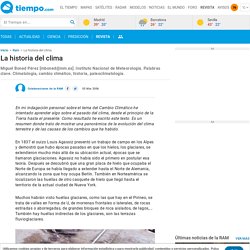
Como resultado he escrito este texto. Es un resumen donde trato de mostrar una panorámica de la evolución del clima terrestre y de las causas de los cambios que ha habido. National Centers for Environmental Information (NCEI) Paleoclimatology: Climate Proxies. Created by Monica Bruckner, Montana State University.
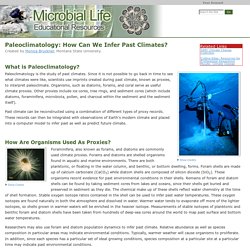
What is Paleoclimatology? Scientists take samples from the center of the coral. Clipperton Atoll, 10°N, 109°W. Photo by Maris Kazmers (courtesy of th NOAA Image Gallery). TIERRA SYLVANA: GLACIARES E INTERGLACIARES Y SUS EFECTOS SOBRE LOS ECOSISTEMAS. Early Human Evolution: Climate Change and Human Evoluti. The evolutionary surge that led to Homo habilis began during the transition between the Pliocene and Pleistocene Epochs around 2.5 million years ago when climates were becoming cooler and drier.
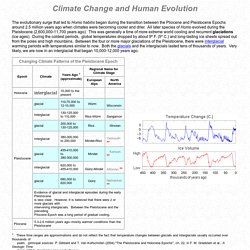
All later species of Homo evolved during the Pleistocene (2,600,000-11,700 years ago). This was generally a time of more extreme world cooling and recurrent glaciations (ice ages). Glacier pano Nature - Photo - Fond-Ecran-Image. Interactive Timeline. Skip to page content A Journey to a New Land Site Resources Menu Multimedia Library Interactive Timeline Download free Flash Player Copyright © SFU Museum of Archaeology and Ethnology, 2005. ¿Cómo llegó el hombre a América? En la madrugada del 12 de octubre de 1492, Rodrigo de Triana, un marinero andaluz a bordo de la Pinta, avistó tierra firme por primera vez después de que cinco semanas atrás hubieran dejado el puerto San Sebastián de La Gomera. Aquella tierra no se trataba de las Indias que la expedición de Cristóbal Colón, si no un nuevo continente descubierto. ¿Cuántas glaciaciones han ocurrido? Ice age sea levels. Handprint : Ancestral Lines. Hominid Fossil Sitesand Patterns of Hominid DispersalWhen and how new hominid species appeared, and how they affected or displaced already existing species, are questions that many lines of research are helping to answer.
Patterns of human migration form a key part of the solution. Recently, with more powerful geological dating methods based on fluctuations in the earth's magnetic field or electron spin resonance, the earliest Homo erectus fossils from China have been dated to 1.9 million years ago. Trailblazers across Arabia. For what they were... we are: The various options for the migration out of Africa. I want to call your attention to the latest entry at M. Petraglia and colleagues' blog Ancient Indian Corridors.
Global Sea Level Rise Map - Global Warming & Climate Change Impact. Out of Africa I - Wikipedia. This article is about early humans. For migrations of modern humans, see Out of Africa II. Climate Swings Drove Early Humans Out of Africa (and Back Again) - SAPIENS. The textbook narrative of human history tells us that between 70,000 and 60,000 years ago our earliest modern human ancestors traveled out of Africa on a journey that led them to nearby continents. But the factors that drove this mass exodus—as well as when it occurred and whether there was more than one big migration event—have long been points of spirited debate and contention. In a study published today in Nature, researchers report that dramatic climate fluctuations created favorable environmental conditions that triggered periodic waves of human migration out of Africa every 20,000 years or so, beginning just over 100,000 years ago.
Migratory Crossings. Out of Africa For the human journey to really get into its stride, our species had to leave the warm embrace of mother Africa. Diputación de Albacete. Mapas Interactivos de Didactalia. Reta a tus amigos a jugar a anatomía humana y celular y química de manera divertida y eficaz Un pack de juegos interactivos de anatomía humana y celula y químicar: · Más de 200 juegos inteligentes · Retos educativos entre alumnos, juego uno contra uno · Torneos, el reto se hace colectivo con desafíos entre grupos de jugadores · Diversos niveles de dificultad y modalidades de juego · Modo estudia para memorizar antes de consolidar lo aprendido en el juego · Analíticas de juego, datos y estadísticas pertinentes para medir los impactos del aprendizaje · Recomendaciones de juegos a practicar y personas a quienes retar · Ranking de juegos para cada juego individual, por ámbitos anatómicos (sistema esquelético, muscular, anatomía celular...), por química y ranking general de anatomía y química · Multiidoma, todos los juegos en 9 idiomas diferentes · Accesibles desde cualquier dispositivo: móvil, tablet u ordenador.
Africa - Relief. Africa Physical Map Quiz. Map of Human Migration. When humans first ventured out of Africa some 60,000 years ago, they left genetic footprints still visible today. Unraveling Our Genetic History. La genètica de les migracions humanes - Revista Mètode. L’estudi d’aquestes variants genètiques del nostre genoma ha demostrat que les poblacions africanes actuals presenten més variants i, per tant, més diversitat genètica que la resta de poblacions humanes. A més, gran part de la diversitat en poblacions no africanes és un subconjunt de les variants que trobem al continent africà.
The Origin of Us. Who are we? Where did we come from? Why are we here? The age-old question of our origin has been baffling mankind for centuries. For most of our history, it was widely accepted that man had been created by an omnipresent, omnipotent, God or Gods. The Ancient World Unit: Multiregional Theory or Out of Africa Theory? L'homme de Yamashita-cho. Un homme fossile du Pléistocène de l'île d'Okinawa (en anglais) Bull, et Mém. de la Soc. d'Anthrop. de Paris, t. 10, série XIII, 1983, p. 81-87. THE YAMASHITA-CHO MAN. A late Pleistocene infantile skeleton from the Yamashita-cho Cave (Okinawa) by H. David Le Breton:“pensar el cuerpo es pensar el mundo” David Le Breton es doctor en Sociología de la Universidad París VII y miembro del Instituto Universitario de Francia.
Imitación, lenguaje y socialidad. Monash University: Sahul Time: Explore. Mouse click reveals ancient coastline › News in Science (ABC Science) News in Science Wednesday, 3 October 2007 Anna SallehABC. Science Teaching Materials, Activities, Worksheets, and Lesson Plans. DMNS-Ice Age in Depth. Mapping Mankind’s Trek – Ancient Coastlines and Land Bridges. Com feien foc els nostres avantpassats? Tools & Food. PBS: Public Broadcasting Service. The Making of the Fittest: Natural Selection and Adaptation. Dropbox. BECOMING HUMAN - NOVA - Discovery/Science/History (documentary) Teaching Evolution through Human Examples. Somebody That I Used to Know - Walk off the Earth (Gotye - Cover) Suport ap co. Coneixement del Medi. Unitat Didàctica 12: Vivim en comunitat.
Recursos per als mestres. escola puig d'arques. Joc de l'esquelet on Scratch. ES RACÓ DES PT - EL RINCÓN DEL PT: L'esquelet escala 1/1 en castellà, català i anglès. L'esquelet. Relacionar Mosaico Hábitos de higiene . biología. Javier Queza... Skeleton Game 1 - Anatomy - Health. Exposicions. Tots x Tots » Ètnies del món. Google. La Pedra Filosofal. Selección Natural. Com elaborar un eix cronològic. Year-by-Year World Population Estimates: 10,000 B.C. to 2007 A.D. Visualizing How A Population Grows To 7 Billion. Evolución de la Población. La prehistòria. Lesson 1: The Peopling of Our Planet - World Population. Statistical software & data analysis add-on for Excel.
Culture Collections that begin with A on eHRAF World Cultures. Culture Collections that begin with A on eHRAF World Cultures.